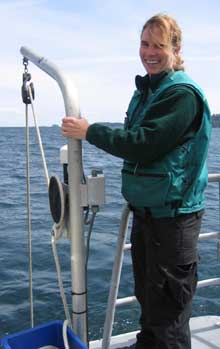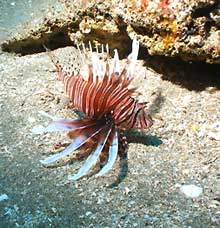How to Apply
The Call for Applications for NOAA's Teacher at Sea 2009 Field Season is now CLOSED. Please read below for details if you are interested in applying for the 2010 Season.

Time Committment
Criteria for Selection
Obligations as a TAS
Costs
Application Materials
Call for Applications
NOAA's Teacher at Sea Program call for applications the 2009 Field Season is now CLOSED. Please read below for details if you are interested in applying for the 2010 Season.
Time Committment
Participants can expect to be at sea anywhere from one week to one month, with the average cruise lasting 12-14 days. Most of our participants try to sail on cruises offered during the summer vacation, but cruises take place throughout most of the year on a space-available basis.
Because of Homeland Security reasons, specific NOAA ship schedules are no longer made available to the public. Therefore, we ask applicants to list all the dates they will be available to sail on their application so that we can then match participants' requests to a ship's schedule. The public may view NOAA's fleet allocation plan by going to http://www.omao.noaa.gov/shipallocation.html
(top)
Criteria for Selection
To be considered for becoming a NOAA Teacher at Sea, you will be expected to:
- Provide evidence of good health as determined by a completed medical history and have passed a TB test within 12 months of your sailing date. Applications received without a completed heath questionnaire will not be considered.
- IMPORTANT: Some cruises, especially fisheries cruises, require high-intensity work that demands physical adeptness and endurance. Work shifts on some ships may be 4 hours on/4 hours off, 6 hours on/6 hours off, or 12 hours on/ 12 hours off. You may also be required to work a night shift.
- Be currently employed, full-time, as:
- a K-12 teacher or administrator
- a community college, college, or university teacher
- a museum or aquarium educator
- an adult education teacher
- We regret that we cannot accept applications from part-time, substitute, or pre-service teachers.
- Have flexibility and the ability to cope with the uncertain (see "Life at Sea")
- Have a unique ability to communicate complicated information to students, with a special interest in NOAA-related science.
- Have a principal/supervisor/department head who is supportive of your endeavor.
- Have superior English language ability (dual language ability is a plus).
- Be comfortable with travel and have no aversions to traveling by airplane or ship.
- Be computer literate.
- You are not required to have a passport to apply, but your options for cruises may be limited if you are selected because NOAA ships sometimes travel into international waters, for which a passport is required.

(top)
Obligations as a Teacher at Sea
As a NOAA Teacher at Sea, you must be willing to fulfill several program requirements during and upon completion of your cruise:
- Submit 2 to 3 logs per week with digital photographs while at sea or upon return.
- Submit receipts and travel voucher for reimbursement.
- Submit a post-cruise survey.
- Submit one lesson plan that addresses the science and research that was being conducted on the mission.
- Submit one lesson plan, activity, or similar document (e.g. brochure, flyer) that addresses ocean careers.
- Create and administer a test before and after teaching your lesson plan that measures students’ knowledge of the lesson’s subject matter as appropriate to grade level.
- Submit one copy of the test and its overall results, both pre- and post-lesson.
- Submit an article for publication OR conduct a presentation about your mission at an educators' conference or for colleagues.
(top)
Once selected, teachers will be assigned to a vessel on a space-available basis only. They will work with the scientific team under the direction of the Chief Scientist and the ship's Commanding Officer. Independent scientific projects must be coordinated with the Chief Scientist.
Due to security reasons, we cannot publish our ship schedules. For information about the ships and mission descriptions, please visit our Ships page as well as our Ship Allocation Plan.
General Shipboard Policy Information contains useful information about ship policies and procedures. Some individual ship's pages also have further information for visiting teachers about life aboard a ship. One site, supported by the Northeast Fisheries Science Center, has a very useful manual for cruise volunteers and first-time sailors about life at sea. Please note that NOAA Teachers at Sea are not permitted under any circumstances to SCUBA dive even if he or she has been SCUBA certified. If you are interested in information about SCUBA diving, please visit the NOAA Dive Center site.
(top)
Costs
All necessary travel costs are paid for by the NOAA Teacher at Sea Program. While airfare is paid for up front by the government, all other costs are reimbursed, including transportation costs, hotel costs, and per diem allowance.
Application materials for our 2010 Season will become available beginning October 1, 2009.
Site Index | About the Site | Privacy Policy
